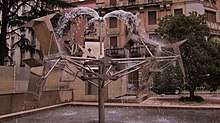Susumu Shingu
Susumu Shingū is a kinetic sculptor from Japan. His nature-inspired works are constructed of highly engineered materials, commonly steel and Teflon.
Susumu Shingū | |
|---|---|
| Born | July 13, 1937 |
| Nationality | Japanese |
| Known for | Sculpture |
Notable work | Gift of the Wind |
| Movement | Kinetic art, Abstract art |
Biography

Early Years
Susumu Shingu, was born in Osaka, Japan, in 1937. He matriculated at the University of Fine Arts in Tokyo in 1956, with a concentration in oil painting. A bursary from the Italian government followed, allowing him to travel to Italy where his intention was to study figurative painting.[1] He attended the Accademia di Belle Arti di Roma from 1960 to 1962. By his own account, Shingu's interest in sculpture developed as his interest in abstraction was expanding. He hung a painting outside to record it photographically: the wind interferred. He became fascinated by the potential for three-dimensional movement. "The work that followed relied on natural forces to make it move or make sound, and he began using more sophisticated materials for outdoor works,"[2] as traditional art materials were either too heavy to supply graceful natural movement or too quickly degraded under outdoor conditions.
Osaka Ship Building Company
Still in Italy, a chance meeting with Kageki Minami, the president of Osaka Ship Building Company, led to Shingu's return to Japan, where Minami allowed him a studio in his shipyard and access to the talents of company engineers. With this support, Shingu produced “Path of Wind,” a 20-meter-tall sculpture that was his first large-scale commissioned piece.[3] He began to produce work incorporating elements from his study of the Japanese folk arts: wind chimes and traditional carp banners.[4]
Expo '70 in Tokyo was a major event on the arts scene in Japan. Shingu was one of eight Japanese sculptors chosen to represent the nation. The organizers commissioned a large piece from Shingu for the central plaza.[5]
He spent a year at Harvard University as a Visiting Artist at Harvard's Carpenter Center for the Visual and Environmental Studies, 1971 to 1972.[6]
Traveling Exhibitions
Shingu, a prolific artist, has participated in numerous group and solo exhibitions internationally. Additionally, he has collaborated in theatre projects (including variations on tradition Japanese Nô performance[7]) and published a number of children's books. His work has been honored with many awards, including the Outdoor Sculpture Prize of Nagano City and the Japan Grand Prix of Art.[6]
Wind Museum
The 3,000-sq.-meter Susumu Shingu Wind Museum is an open-air sculpture garden in Sanda, Japan, established in 2012.
Exhibitions & Traveling Shows
- Windcircus, (1987) Bremen, Germany; Barcelona, Spain; Florence, Italy; Lahti, Finland; New York City, Fall River, Boston, Chicago, and Los Angeles,United States; Nagano, Japan[4]
- Cosmos (2018), Galerie Jeanne Bucher Jaeger, Paris, France[8]
- Wind Caravan (2019–20) Japan [1]
Quotations
"My works are ways of translating the messages of nature into visible movements"[1]
External Links
References
- "Susumu Shingu: An Ode to Nature". Pen Magazine International. Retrieved 2020-04-22.
- "Susumu Shingu — Portfolio". Slash Paris. Retrieved 2020-04-23.
- Yamada, Mio (2014-10-02). "Susumu Shingu knows which way the wind blows". The Japan Times. Retrieved 2020-04-22.
- "TimesMachine: Sculptures That Frolic in the Wind - NYTimes.com". timesmachine.nytimes.com. Retrieved 2020-04-22.
- Shingu, Susumu (1997). Shingu: Message From Nature. Abbeville Press. ISBN 0789203804.
- Radar, Art. "Ad (In)Finitum: Japanese artist Susumu Shingu's "Spaceship" at MUDAM Luxembourg | Art Radar". Retrieved 2020-04-22.
- Benoit, Guillaume (2018). "Susumu Shingu — Galerie Jeanne Bucher Jaeger — Critique". slash-paris.com. Retrieved 2020-04-23.
- "Susumu Shingu — Galerie Jeanne Bucher Jaeger — Critique". slash-paris.com. Retrieved 2020-04-23.